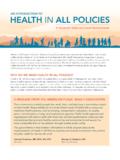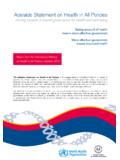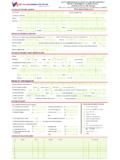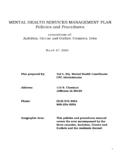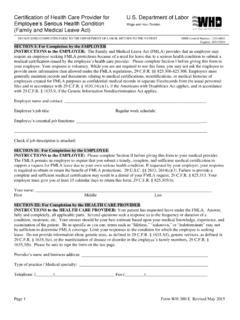Transcription of Health in All Policies (HiAP) Framework for Country …
1 Health in All Policies (HiAP) Framework for Country ActionJanuary 2014 CONTENTSS ummary ..1 What is HiAP? ..2 Background ..2 Concept and principles ..3 Why it matters ..4 How to implement the Framework ..61. Establish the need and priorities for HiAP ..62. Frame planned action ..73. Identify supportive structures and processes ..84. Facilitate assessment and engagement ..95. Ensure monitoring, evaluation and reporting ..106. Build capacity ..10 Roles and responsibilities ..11A key role for the Health sector ..11 Global action ..12 The role of WHO ..12 Moving forward ..13 References ..14 Annex 1. Examples of HiAP key result areas..151F r a m e w o r k f o r C o u n t r y A c t i o nSUMMARYThis document serves as a starter s kit for applying Health in All Policies (HiAP) in decision-making and implementation at national and subnational levels.
2 It can be easily adapted for use in different Country contexts and at the regional and global levels. WHAT IS HIAP?HiAP is an approach to public Policies across sectors that systematically takes into account the Health implications of decisions, seeks synergies, and avoids harmful Health impacts in order to improve population Health and Health equity. As a concept, it reflects the principles of: legitimacy, accountability, transparency and access to information, participation, sustainability, and collaboration across sectors and levels of IT MATTERSH ealth and Health equity are values in their own right, and are also important prerequisites for achieving many other societal goals. Many of the determinants of Health and Health inequities in populations have social, environmental, and economic origins that extend beyond the direct influence of the Health sector and Health Policies .
3 Thus, public Policies in all sectors and at different levels of governance can have a significant impact on population Health and Health equity. HOW TO IMPLEMENT THE FRAMEWORKThe Framework sets out six key components that should be addressed in order to put the HiAP approach into action:1. Establish the need and priorities for HiAP2. Frame planned action3. Identify supportive structures and processes4. Facilitate assessment and engagement5. Ensure monitoring, evaluation, and reporting6. Build components are not fixed in order or priority. Rather, individual countries will adopt and adjust the components in ways that are most relevant for their specific governance, economic and social AND RESPONSIBILITIESA lthough governments as a whole bear the ultimate responsibility for the Health of their citizens, Health authorities at all levels are key actors in promoting HiAP.
4 They should therefore actively seek opportunities to collaborate with and influence other sectors. Intergovernmental organizations and structures (multilateral, bilateral, regional, etc.) can provide significant support to multisectoral action on Health and development outcomes. Finally, having taken a lead role in multisectoral initiatives on issues such as marketing of breast-milk substitutes, tobacco control, and the international recruitment of Health personnel, WHO has a special contribution to make to HiAP at both international and Country e a l t h i n A l l P o l i c i e s ( H i A P )WHAT IS HIAP?Governments have a responsibility for the Health of their peoples which can be fulfilled only by the provision of adequate Health and social Constitution of the World Health Organization, 1946 The Eighth Global Conference on Health Promotion was held in Helsinki, Finland from 10th-14th June 2013, with the theme Health in All Policies .
5 This Framework document is based on the work done prior to, during and subsequent to that conference. It summarizes current thinking about the HiAP approach and provides a starter s kit for applying HiAP in decision-making and implementation at national and subnational levels. It is applicable to all countries and policy contexts, including development the context of this Framework , multisectoral action refers to actions between two or more sectors within government (such as Health , transport and environment), and is used as a synonym for intersectoral action. When referring to actors outside the government (such as non-governmental, private sector, professional, or faith-based organizations) the term multistakeholder is its roots can be traced to the very origins of World Health Organization, the Health in All Policies approach builds on a rich heritage of ideas, actions and evidence that have emerged since the Alma Ata Declaration on Primary Health Care (1978) and the Ottawa Charter for Health Promotion (1986).
6 The Ottawa Charter, which resulted from the First International Conference on Health Promotion, provides a cornerstone for Health promotion. It identifies the paramount importance of Health equity, and of five key Action Areas. These in turn became the focus of the Conference in Adelaide in 1988, where principles and practices for healthy public policy were highlighted, as well as the focus of subsequent Health promotion conferences on achieving Health and Health equity through creating a Health -conducive environment, building effective partnership, addressing social determinants, and taking Country HiAP approach has been reinforced in the more recent 2011 Rio Political Declaration on Social Determinants of Health (WHO 2011a), and the UN General Assembly Resolution on the Prevention and Control of Non-Communicable Diseases (United Nations 2011).
7 3F r a m e w o r k f o r C o u n t r y A c t i o nCONCEPT AND PRINCIPLESHiAP is an approach to public Policies across sectors that systematically takes into account the Health implications of decisions, seeks synergies, and avoids harmful Health impacts in order to improve population Health and Health is founded on Health -related rights and obligations, and contributes to strengthening the accountability of policymakers for Health impacts at all levels of policy-making. It emphasizes the consequences of public Policies on Health systems, determinants of Health , and well-being. It also contributes to sustainable is recognized that governments are faced with a range of priorities and that Health and equity may not automatically gain precedence over other policy objectives.
8 Nonetheless, Health considerations do need to be taken into account in policy-making. Efforts must be made to capitalize on opportunities for co-benefits across sectors and for society at large. Effective safeguards to protect Policies from distortion by commercial and vested interests and influence also need to be a concept, HIAP is in line with the Universal Declaration of Human Rights, the United Nations Millennium Declaration, and accepted principles of good governance (UNDP 1997). In particular, HiAP reflects the principles of:n legitimacy grounded in the rights and obligations conferred by national and international lawn accountability of governments towards their peoplen transparency of policy-making and access to informationn participation of wider society in the development and implementation of government Policies and programmesn sustainability in order that Policies aimed at meeting the needs of present generations do not compromise the needs of future collaboration across sectors and levels of government in support of Policies that promote Health , equity, and e a l t h i n A l l P o l i c i e s ( H i A P )
9 WHY IT MATTERSH ealth and Health equity are values in their own right, and are also important prerequisites for achieving many other societal goals. Many of the determinants of Health and Health inequities in populations have social, environmental, and economic origins that extend beyond the direct influence of the Health sector and Health Policies . Thus, public Policies and decisions made in all sectors and at different levels of governance can have a significant impact on population Health and Health equity. The HiAP approach is therefore necessary to protect and promote Health and Health equity, particularly where there are competing interests. It ensures that Health and Health equity considerations become part of provides a means to identify and avoid those unintended impacts of public policy that can be detrimental to the Health of populations or subgroups of the population, thus reducing risk.
10 HIAP IN PRACTICEHiAP has been used widely with considerable success, and there is now considerable documentation of initiatives reflecting the HiAP approach (WHO 2011b; WHO 2013a; Howard & Gunther 2012; Leppo et al 2013; Perrier & Shankardass 2011; McQueen et al 2012; Rudolph et al 2012 ; Kickbusch and Gleicher 2012).). The following examples dem-onstrate how Health objectives can be furthered through Policies that cut across a number of sectors, both nationally and internationally, while fulfilling HiAP s fundamental principles. ECUADOR: THE NATIONAL GOOD LIVING PLANE cuador s Plan Nacional para el buen vivir (National Plan of Good Living, or NPGL) has become the roadmap for the development and implementation of social Policies in Ec-uador, with the full backing of the highest political authority.










